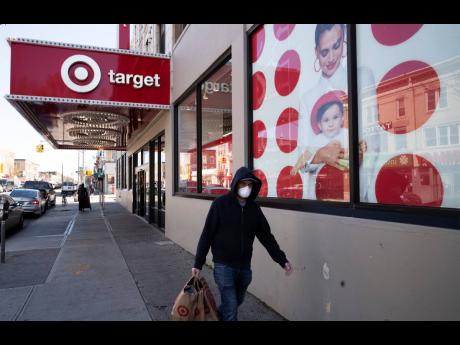Target online sales pay-off for retailer
Online sales at Target more than doubled as the pandemic put millions in lockdown during the first quarter, revealing further the critical role big box stores played in getting supplies to an immobilised population.
The Minneapolis company reported Wednesday that comparable-store sales, which include online purchases, rose 10.8 per cent for the three-month period that ended May 2.
That was fuelled by a 12.5 per cent jump in the number of items customers bought with each trip to the store as families made major restocking runs, but fewer of them.
“Last quarter was unlike anything I have ever seen,” Target’s CEO Brian Cornell told reporters on a conference call. “It was intense. It was volatile. It was stressful for our guests and for the country.”
The pandemic has widened an already growing rift between big box retailers that deftly followed consumers online, and those, particularly mall-based clothing chains, that have struggled. Walmart this week reported a 74 per cent surge in US online sales for the first quarter. Same-store sales rose 10 per cent at its United States-based stores.
J. Crew, Stage Stores, Neiman Marcus and J.C. Penney, filed for bankruptcy protection this month.
A years-long campaign by Walmart and Target to challenge Amazon.com online was, as it turns out, a dry run for a pandemic.
Target had already transformed its 1,800 stores into distribution hubs, putting it in a better position than even Amazon.com to keep supplies flowing. Its stores were directly involved in supplying goods for 80 per cent of online sales. Same-day services, such as kerbside pickup at stores for things ordered online, nearly tripled.
The company has five million new users on its website, and two million have begun relying on Target’s services like kerbside pickup for things ordered online.
Target picked up market share in all five of its merchandise categories, Cornell said. Sales of items like furniture and electronics surged 20 per cent. It was the same for groceries.
Target’s clothing sales, which deliver high margins for retailers, fell 20 per cent during the quarter. However, that business began to rebound at the tail end of the quarter. Cornell cites government stimulus checks.
Walmart saw the same stimulus-check related bump to sales in April.
As with other retail companies operating in a pandemic, costs soared as well. Target spent and additional US$500 million on things directly related to the outbreak. It’s bumped up hourly pay for workers by US$2. It has now extended emergency pay for those workers to July 4. Target also spent money to sanitise stores and warehouses, new protections for workers an signage for customers to ensure social distancing.
Cornell said those costs will be the new reality going forward.
“There is going to be a premium on creating a safe sanitised shopping environment,” he said. Shopping while minimising human contact is the new normal, he said, referring to drive-up and kerbside pickup.
Target reported an 11.3 per cent increase in revenue, which hit US$19.62 billion for the quarter. Analysts surveyed by FactSet expected US$19.02 billion. Net earnings slid 64 per cent to US$284 million, or 56 cents, or 59 cents when adjusted for non-recurring events. That’s far better than the per-share profit of 44 cents that Wall Street was expecting, according to a survey of analysts by FactSet.
AP

